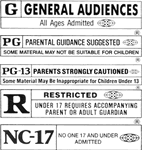Management: Issues: Rating Systems, Labels, and Permission Slips
Censorship is contagious, and experience with this culture of regulation teaches that regulatory enthusiasts herald each new medium of communications as another opportunity to spread the disease - Robert Corn-Revere (Chief Counsel to FCC Interim Chairman James Quello)
Some libraries used popular rating systems to determine which audio and video programs or video games can be checked out to children and young adults. A few libraries even use them to make purchase decision. Centers sometimes use rating systems to label materials. Many schools require permission slips before students can view videos. Is this censorship or good practice? You decide.
 From rating systems
and CD labels to viewing restrictions and video permission slips, there
are an increasing number of guidelines and procedures focused on restricting
access to audio and video information. While some people call these
activities essential in protecting children, others feel that they restrict
basic freedoms.
From rating systems
and CD labels to viewing restrictions and video permission slips, there
are an increasing number of guidelines and procedures focused on restricting
access to audio and video information. While some people call these
activities essential in protecting children, others feel that they restrict
basic freedoms.
![]() Consider the pros
and cons of using rating systems as part of the selection process.
Also, consider the pros and cons of using the rating systems in determining
who can checkout or view audio, video, or video game materials.
Consider the pros
and cons of using rating systems as part of the selection process.
Also, consider the pros and cons of using the rating systems in determining
who can checkout or view audio, video, or video game materials.
Official
Rating Systems: Audio, Video, and Video Games
Rating systems are used to help people make listening and viewing decisions. They are often associated with issues such as theme, language, nudity and sex, and violence. Use the following links to learn more about these systems.
- Motion
Picture Association of America
(MPAA)
- How Movies are Rated
- MPAA Film Rating System from Wikipedia
- Entertainment Software Rating Board (ERSB)
- FAB Rating System from Film Advisory Board - for direct to video movies
- Information for Parents from Recording Industry Association of America (music labels)
- Canadian Rating System for Home Videos
Other Rating Systems and Movie Guides
Many groups have developed rating systems and guides. Often developed by "family friendly" or Christian groups they focus on providing descriptions of films to assist parents in making informed decisions. Some of these groups also advocate "edited" versions of feature films.
- Dove Foundation - "family friendly" group (also "family-edited" editions)
- Family Movie Guide from New York Times Learning Network
- Grading the Movies - first appeared as a weekly newspaper column in 1993
- Kids-In-Mind: Movie Ratings That Actually Work from Critics Inc.
- Movie Mom - reviews on the site are written by the "Movie Mom" herself, Nell Minow, a film critic and mother of two teenagers.
- Parental Media Guide - rating of movies, television, records & cd’s, and computer, video, and Internet games
- Rating Game from The Freedom Forum - explores the debate over rating entertainment for offensive content in three parts and an addendum
- Ratings Game: Choosing Your Child’s Entertainment from American Academy of Pediatrics
- Reasons for Movie Ratings from The Classification and Rating Administration (CARA)
- TV Parental Guidelines

Video and
Audio Checkout
Some libraries require patrons and/or parents to complete permission slips to check out audio, video, or video game items. Does your local school or public libraries have this requirement? Some examples are found below. Do you think this is necessary? Why or why not?
- Movie/Video Permission Form from Movies In the Classroom
- Parent/Guardian Permission from Nintendo
- Teacher Request to Use Non-School Video from Lugoff-Elgin High School Library Media Ctr, SC
Permission Slips
Some schools and libraries have policies related to video viewing. For example, a school may require parental permission to view a movie containing anything but a "G" rating. Some schools send home permission slips that only need to be returned if permission is denied.
When video viewing is a part of the lesson tied to standards, alternative learning experiences must be designed for students who do not participate in the activity. For example, students might read a book and write a summary.
Some educators have come up with interesting ways to inform parents about class activities. For example, The Devil's Arithmetic Video Permission Form contains a copy of the back cover of the videotape. The following pages provide information about and examples of video viewing permission slips.
- British Literature Online - permission slip at bottom of page
- Lebanon Community School District - use of feature films/videos in the school
- Instructional Materials from Federal Way Public Schools
- Video Permission Slips from Jordan High School - provides a video synopsis and student video release form.
- Springfield Township High School Video Policies
- Video Viewing Permission Slip - MS Word document
When designing a permission slip, consider including information about how the audio or video contributes to the learning environment. Ideas can be found below:
- Latest Movie Lesson Plans from ClassBrain
- Teach
with the Movies
Learning Guides to each recommended film describe the benefits of the movie, possible problems, and helpful background. Discussion questions, bridges to reading, projects and links to the internet are also provided.

![]() Watch a historical
fiction movie. Do you think it would be appropriate for middle school
or high school students? Why or why not? What standards might it
address? Why would a teacher choose to use a video rather than other
resources
to teach this content? If you were designing a permission form to
send to parents, what information would you provide about the content
of the film as well as the content of the curriculum? For example,
the webQuest The
Costs of War uses a war movie such as "Schindler's
List",
"Good Morning Vietnam", or "Saving
Private Ryan".
Watch a historical
fiction movie. Do you think it would be appropriate for middle school
or high school students? Why or why not? What standards might it
address? Why would a teacher choose to use a video rather than other
resources
to teach this content? If you were designing a permission form to
send to parents, what information would you provide about the content
of the film as well as the content of the curriculum? For example,
the webQuest The
Costs of War uses a war movie such as "Schindler's
List",
"Good Morning Vietnam", or "Saving
Private Ryan".